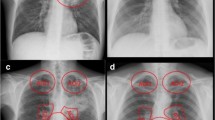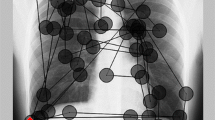Abstract
A radiologist’s search pattern can directly influence patient management. A missed finding is a missed opportunity for intervention. Multiple studies have attempted to describe and quantify search patterns but have mainly focused on chest radiographs and chest CTs. Here, we describe and quantify the visual search patterns of 17 radiologists as they scroll through 6 CTs of the abdomen and pelvis. Search pattern tracings varied among individuals and remained relatively consistent per individual between cases. Attendings and trainees had similar eye metric statistics with respect to time to first fixation (TTFF), number of fixations in the region of interest (ROI), fixation duration in ROI, mean saccadic amplitude, or total number of fixations. Attendings had fewer numbers of fixations per second versus trainees (p < 0.001), suggesting efficiency due to expertise. In those cases that were accurately interpreted, TTFF was shorter (p = 0.04), the number of fixations per second and number of fixations in ROI were higher (p = 0.04, p = 0.02, respectively), and fixation duration in ROI was increased (p = 0.02). We subsequently categorized radiologists as “scanners” or “drillers” by both qualitative and quantitative methods and found no differences in accuracy with most radiologists being categorized as “drillers.” This study describes visual search patterns of radiologists in interpretation of CTs of the abdomen and pelvis to better approach future endeavors in determining the effects of manipulations such as fatigue, interruptions, and computer-aided detection.







Similar content being viewed by others
References
Samuel S, Kundel HL, Nodine CF, Toto LC: Mechanism of satisfaction of search: Eye position recordings in the reading of chest radiographs. Radiology. 194(3):895–902, 1995. https://doi.org/10.1148/radiology.194.3.7862998
Kundel HL, Nodine CF, Krupinski EA: Searching for lung nodules: Visual dwell indicates locations of false-positive and false-negative decisions. Invest Radiol. 24(6):472–478, 1989. https://doi.org/10.1097/00004424-198906000-00012
Berbaum KS, Franken EA, Dorfman DD et al.: Role of faulty visual search in the satisfaction of search effect in chest radiography. Acad Radiol. 5(1):9–19, 1998.http://www.ncbi.nlm.nih.gov/pubmed/9442202. Accessed March 21, 2017
Kundel, H. L., Nodine, C. F., & Carmody, D. Visual scanning, pattern recognition and decision-making in pulmonary nodule detection. Investigative Radiology, 13(3), 175–181, 1978. http://doi.org/10.1097/00004424-197805000-00001
Drew T, Evans K, Võ ML-H, Jacobson FL, Wolfe JM: Informatics in radiology: What can you see in a single glance and how might this guide visual search in medical images? RadioGraphics. 33(1):263–274, 2013. https://doi.org/10.1148/rg.331125023
Kelly BS, Rainford LA, Darcy SP, Kavanagh EC, Toomey RJ: The development of expertise in radiology: In chest radiograph interpretation, “expert” search pattern may predate “expert” levels of diagnostic accuracy for pneumothorax identification. Radiology. 280(1):252–260, 2016. https://doi.org/10.1148/radiol.2016150409
Kundel HL, Nodine CF, Conant EF, Weinstein SP: Holistic component of image perception in mammogram interpretation: Gaze-tracking study. Radiology. 242(2):396–402, 2007. https://doi.org/10.1148/radiol.2422051997
Cooper, L., Gale, A., Darker, I., Toms, A., & Saada, J. (2009). Radiology image perception and observer performance: How does expertise and clinical information alter interpretation? Stroke detection explored through eye-tracking (p. 72630K), 2009. http://doi.org/10.1117/12.811098.
Drew T, Vo ML-H, Olwal A, Jacobson F, Seltzer SE, Wolfe JM: Scanners and drillers: Characterizing expert visual search through volumetric images. J Vis. 13(10), 2013. https://doi.org/10.1167/13.10.3
Williams LH, Drew T: Distraction in diagnostic radiology: How is search through volumetric medical images affected by interruptions? Cogn Res Princ Implic. 2(1):12, 2017. https://doi.org/10.1186/s41235-017-0050-y
Rubin GD, Roos JE, Tall M, Harrawood B, Bag S, Ly DL, Seaman DM, Hurwitz LM, Napel S, Roy Choudhury K: Characterizing search, recognition, and decision in the detection of lung nodules on CT scans: Elucidation with eye tracking. Radiology. 274(1):276–286, 2015. https://doi.org/10.1148/radiol.14132918
Helbren E, Halligan S, Phillips P, Boone D, Fanshawe TR, Taylor SA, Manning D, Gale A, Altman DG, Mallett S: Towards a framework for analysis of eye-tracking studies in the three dimensional environment: A study of visual search by experienced readers of endoluminal CT colonography. Br J Radiol. 87(1037):20130614, 2014. https://doi.org/10.1259/bjr.20130614
Ratwani RM, Wang E, Fong A, Cooper CJ: A human factors approach to understanding the types and sources of interruptions in radiology reading rooms. J Am Coll Radiol. 13(9):1102–1105, 2016. https://doi.org/10.1016/j.jacr.2016.02.017
Bertram R, Helle L, Kaakinen JK, Svedström E. The effect of expertise on eye movement behaviour in medical image perception. Paterson K, ed. PLoS One. 8(6):e66169, 2013. doi:https://doi.org/10.1371/journal.pone.0066169.
Salvucci DD, Goldberg JH. Proceedings : Eye Tracking Research & Applications Symposium 2000 : Palm Beach Gardens, FL, November 6–8, 2000. In: Association for Computing Machinery; 2000:71–78. https://dl-acm-org.ezproxy.galter.northwestern.edu/citation.cfm?id=355017. Accessed August 15, 2018.
Manning D, Ethell S, Donovan T, Crawford T: How do radiologists do it? The influence of experience and training on searching for chest nodules. Radiography. 12(2):134–142, 2006. https://doi.org/10.1016/j.radi.2005.02.003
Giovinco NA, Sutton SM, Miller JD, Rankin TM, Gonzalez GW, Najafi B, Armstrong DG: A passing glance? Differences in eye tracking and gaze patterns between trainees and experts reading plain film bunion radiographs. J Foot Ankle Surg. 54(3):382–391, 2015. https://doi.org/10.1053/j.jfas.2014.08.013
Ellis SM, Hu X, Dempere-Marco L, Yang GZ, Wells AU, Hansell DM: Thin-section CT of the lungs: Eye-tracking analysis of the visual approach to reading tiled and stacked display formats. Eur J Radiol. 59(2):257–264, 2006. https://doi.org/10.1016/j.ejrad.2006.05.006
Mayo E. Hawthorne and the Western Electric Company First Phase-The Test Room. In: The Social Problems of an Industrial. ; 161–182, 1949. doi:https://doi.org/10.1017/CBO9781107415324.004.
Author information
Authors and Affiliations
Corresponding author
Electronic supplementary material
ESM 1
(PDF 717 kb)
Rights and permissions
About this article
Cite this article
Kelahan, L.C., Fong, A., Blumenthal, J. et al. The Radiologist’s Gaze: Mapping Three-Dimensional Visual Search in Computed Tomography of the Abdomen and Pelvis. J Digit Imaging 32, 234–240 (2019). https://doi.org/10.1007/s10278-018-0121-8
Published:
Issue Date:
DOI: https://doi.org/10.1007/s10278-018-0121-8




